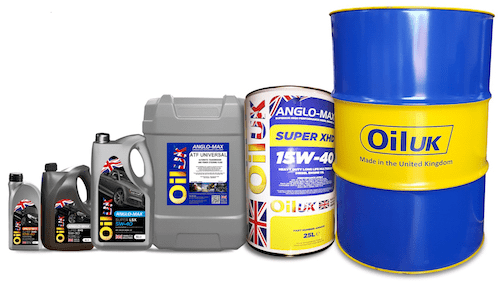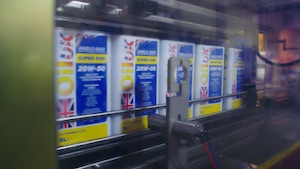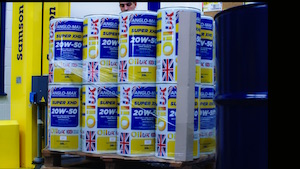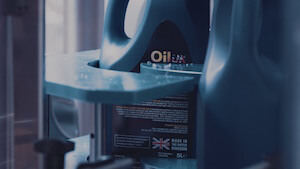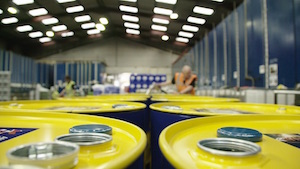HOW DO HEAT TRANSFER FLUIDS DEGRADE?
With literally thousands of uses for heat transfer fluids, it is nearly impossible for any heat transfer fluid manufacturer to recommend an exact oil change interval or maintenance schedule. Each application has its own unique characteristics that can contribute to the degradation of a heat transfer fluid, as well as each heat transfer fluid will react differently in different user environments.
To begin, we should understand the two basic ways in which a heat transfer fluid can become degraded.
Oxidative
In layman terms, oxidation occurs when hot fluid comes in contact with oxygen. Signs of fluid oxidation are seen most evident as sludge formation within the system especially in low-flow areas such as reservoirs or expansion tanks.
What is Oxidation?
Over time, oil tends to break down by reacting with dissolved atmospheric oxygen. This oxidation starts a chain reaction that first forms hydro peroxides and then progresses to oxidation by-products – all of which increase the acidity and viscosity, darken oil colour and leave surface deposits and varnishes.A more viscous fluid will be more difficult to pump, have poorer heat transfer characteristics as well as an increased chance of coke formation. Oxidation is also accompanied by an increase in the acidity (TAN) of the fluid.
Thermal
In layman terms, thermal degradation is overheating the oil past its boiling point. As the fluid boils, much like water, it produces a lighter component in the form of vapors. Excessive overheating or cracking can cause reduced viscosity as well as pose safety concerns with the creation of the lighter components which in turn reduces the overall flash point, fire point and auto-ignition temperatures.
Thermal degradation, or thermal cracking, is the breaking of carbon-carbon bonds in the fluid molecules by heat to form smaller fragments which are free radicals. The reaction may either stop at that point, in which case smaller molecules than previously existed are formed, or the fragments may react with each other to form polymeric molecules larger than previously existed in the fluid. In heat transfer terminology, the two types of degradation products are known as "low boilers" and "high boilers".
If thermal degradation occurs at extremely high temperatures, the effect is not only to break carbon-carbon bonds but to separate hydrogen atoms from carbon atoms and form coke. In this case, fouling of the heat transfer surfaces is very rapid and the system will soon cease to operate.
The effect of the low boilers is to decrease the flash point and viscosity of the fluid as well as to increase its vapor pressure. The effect of the high boilers is to increase the viscosity of the fluid as long as they remain in solution. However, once their solubility limit is exceeded, they begin to form solids which can foul the heat transfer surfaces.
Closed Systems
In theory, most closed systems, using a good quality heat transfer fluid and operated properly should not have a major concern for premature fluid degradation as long as the systems is not run above the recommended bulk or skin temperature of the fluid. Also oxidation should not be of great concern due to the use of an inert gas blanket. However, often due to factors beyond control such as power or pump failure or inadvertent changes to a system (partially open or closed valves, decommissioning user loops, etc.), these systems can experience thermal degradation, often unknown to the user on a day-to-day basis.
As a fluid oxidizes, it forms an acid. These acids, while generally not at corrosive levels, can build and eventually polymerize (drop out) of the fluid in the form of heavy, grease like sludges.
By following a fluid condition analysis program it will be possible to achieve early detection of any changes to a fluid allowing time for system corrections (to stop the fluid degradation) and often improve the fluid’s condition.
Changing the fluid
When analysis indicates that the time has come to change the fluid it is important to remove all traces of the previous fluid otherwise remaining contaminates will quickly degrade the new fluid, reduce system efficiency and reduce fluid life. We recommend the use of Oil UK Flushing Additive Concentrate or Oil UK Flushing Oil as the best way to avoid this. Maintaining your fluid change-out schedule will keep equipment clean and running at peak efficiency. Neglecting maintenance schedules can be problematic and can ultimately cause complete failure
Not All Heat Transfer Fluids are Equal
Not all heat transfer fluids are equal, and the rate of degradation in any system will depend on the molecular structure which governs the thermal and oxidative stability of the fluid and its resistance to breakdown at very high temperatures.
Oil UK are market leaders in heat transfer oil technology. We offer a range of fluids that offer high to ultra-high resistance to thermal and oxidative degradation to suit systems operating under moderate to extended very high temperature conditions.
OIL UK THERM 32
Our range starts with Therm 32, a highly popular low-toxicity mineral oil based product that contains oxidation inhibitors, offering high levels of oxidation and thermal stability.
THERM 32 provides excellent comparative performance against leading competitor equivalent type products such as Shell S2, BP Transcal N and Globaltherm M
OIL UK ULTRA-THERM
For systems requiring increased levels of thermal and oxidative stability Oil UK offers ULTRA-THERM. This is a pure, non-toxic water white synthetic fluid which exhibits low volatility and superior performance at continuously high operating temperatures. ULTRA-THERM is a new generation high performance synthetic heat transfer fluid recommended for all kinds of industrial processes including food, feed and drink plants where a non-toxic fluid is advisable, but where NSF Food Approval is not a specified requirement.
OIL UK THERMALTRANS FG
For ultimate performance we offer Oil UK THERMALTRANS FG. This is a unique, market leading heat transfer fluid based on the very latest synthetic oil technology which exhibits outstanding levels of thermal and oxidative stability. THERMALTRANS FG is also food safe, making it the highest performing NSF Food Approved and Listed product on the market. This product is also highly price competitive against other leading high temperature fluids, despite offering far superior thermal and oxidative performance.

